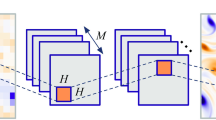Abstract
Particle image velocimetry (PIV) is a powerful tool to study complex flows quantitatively. Post-processing of PIV data is necessary for outlier correction (OC) because of the image noise. Traditional methods detect and correct spurious vectors, respectively, using local statistical models. A new method proposed in this paper iteratively detects and replaces outliers using proper orthogonal decomposition (POD), which can dynamically approximate the original pure velocity field. The new algorithm, named as POD-OC, reconstructs a reference velocity field using low-order POD modes to detect outliers and uses that reference field for OC as well. Compared with the method of normalized median test, POD-OC is more efficient for detecting clustered outliers. It is also more accurate than other common interpolation approaches on outlier fixing. A novel block POD-OC is also designed for post-processing on an instantaneous velocity field, which overcomes the limit that POD can only be applied on a dataset with a large number of instantaneous fields.















Similar content being viewed by others
References
Andrea S, Bernhard W, Fulvio S (2013) PIV uncertainty quantification by image matching. Meas Sci Technol 24(4):045–302
Berkooz G, Holmes P, Lumley JL (1993) The proper orthogonal decomposition in the analysis of turbulent flows. Annu Rev Fluid Mech 25(1):539–575
Cheminet A, Leclaire B, Champagnat F, Cornic P, Le Besnerais G (2013) On factors affecting the quality of tomographic reconstruction. In: Proceedings of PIV13 Delft, Netherlands
Elsinga GE, Tokgoz S (2014) Ghost hunting-an assessment of ghost particle detection and removal methods for tomographic-PIV. Meas Sci Technol 25(8):084004
Elsinga GE, Westerweel J, Scarano F, Novara M (2011) On the velocity of ghost particles and the bias errors in tomographic-PIV. Exp Fluid 50:825–838
Everson R, Sirovich L (1995) Karhunen-love procedure for gappy data. J Opt Soc Am A 12(8):1657–1664
Ganapathisubramani B, Hutchins N, Hambleton WT, Longmire EK, Marusic I (2005) Investigation of large-scale coherence in a turbulent boundary layer using two-point correlations. J Fluid Mech 524:57–80
Garcia D (2011) A fast all-in-one method for automated post-processing of PIV data. Exp Fluids 50:1247–1259
GmbH (2009) http://www.pivtec.com
Gunes H, Rist U (2007) Spatial resolution enhancement/smoothing of stereołparticle-image-velocimetry data using proper-orthogonal-decompositionłbased and kriging interpolation methods. Phys Fluids 19:064101–064119
Gunes H, Sirisup S, Karniadakis GE (2006) Gappy data: to krig or not to krig? J Comput Phys 212(1):358–382
Huang H, Dabiri D, Gharib M (1997) On errors of digital particle image velocimetry. Mea Sci Technol 8(12):1427
Liang DF, Jiang CB, Li YL (2003) Cellular neural network to detect spurious vectors in PIV data. Exp Fluids 34(1):52–62
Lumley JL (1967) The structure of inhomogeneous turbulent flows. In: Yaglom AM, Tatarski VI (eds) Atmospheric turbulence and radio wave propagation. Nauka, Moscow, pp 166–178
Nogueira J, Lecuona A, Rodrłguez PA (1999) Local field correction PIV: on the increase of accuracy of digital PIV systems. Exp Fluids 27(2):107–116
Pan C, Wang HP, Wang JJ (2013) Phase identification of quasi-periodic flow measured by particle image velocimetry with a low sampling rate. Meas Sci Technol 24(5):055–305
Pun CS, Susanto A, Dabiri D (2007) Mode-ratio bootstrapping method for PIV outlier correction. Meas Sci Technol 18(11):3511–3522
Raben SG, Charonko JJ, Vlachos PP (2012) Adaptive gappy proper orthogonal decomposition for particle image velocimetry data reconstruction. Meas Sci Technol 23(2):025–303
Raffel M, Willert CE, Kompenhans J (1999) Particle Image velocimetry, a practical guide. Springer, Heidelberg
Scarano F (2002) Iterative image deformation methods in PIV. Meas Sci Technol 13(1):R1
Shinneeb AM, Bugg JD, Balachandar R (2004) Variable threshold outlier identification in PIV data. Meas Sci Technol 15(9):1722
Sirovich L (1987) Turbulence and the dynamics of coherent structures. I-Coherent structures. II-Symmetries and transformations. III-Dynamics and scaling. Q Appl Math 45:561–571
Thomas L, Tremblais B, David L (2014) Optimization of the volume reconstruction for classical Tomo-PIV algorithms (mart, bimart and smart): synthetic and experimental studies. Meas Sci Technol 25(3):035–303
Venturi D, Karniadakis GE (2004) Gappy data and reconstruction procedures for flow past a cylinder. J Fluid Mech 519:315–336
Westerweel J (1994) Efficient detection of spurious vectors in particle image velocimetry data sets. Exp Fluids 16:236–247
Westerweel J, Scarano F (2005) Universal outlier detection for PIV data. Exp Fluids 39:1096–1100
Acknowledgments
This work is supported by the National Natural Science Foundation of China (11472030, 11102013, 11327202). We would like to thank Professor E. Longmire and Professor B. Ganapathisubramani for providing the PIV data of turbulent boundary layer flow.
Author information
Authors and Affiliations
Corresponding author
Rights and permissions
About this article
Cite this article
Wang, H., Gao, Q., Feng, L. et al. Proper orthogonal decomposition based outlier correction for PIV data. Exp Fluids 56, 43 (2015). https://doi.org/10.1007/s00348-015-1894-x
Received:
Revised:
Accepted:
Published:
DOI: https://doi.org/10.1007/s00348-015-1894-x




